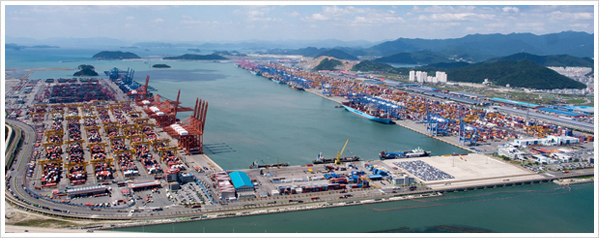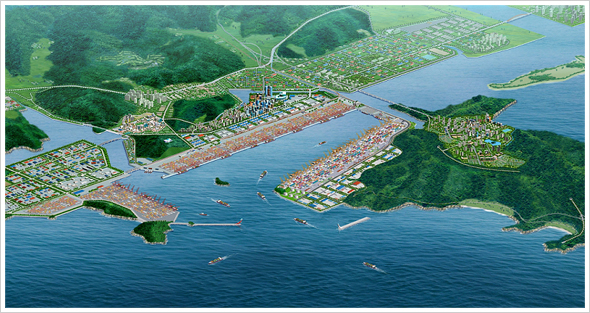
Busan Port
Current Status and Overview of Geographical Conditions
Port facilities: Capacity & Development Progress
Busan Port was opened in 1407 as Busan-po. Since the initial construction of a wharf in 1906, the port has undergone continuous development. It has now been transformed into a modern-day port with an international passenger ferry terminal and 9 container terminals across 4 locations: New Port, Buk-hang (North Port), Gamcheon-hang (Gamcheon Port) and Dadaepo-hang (Dadaepo Port)
Busan Port currently has 40.1 kilometers of quay walls which can accommodate up to 135 vessels and a loading and unloading capacity of over 300 million tons of cargo each year. As the volume of the cargo containers passing through Busan Port steadily increases each year, the city is now working on a project to construct Busan New Port, capable of berthing a total of 61 vessels simultaneously with an annual handling capacity of 35 million TEU. The city plans to complete Busan New Port by 2040.
Busan New Port Construction Project
- Location: Bugan, Gadeokdo Island, Gangseo-gu, Busan Metropolitan City/ around Yongwon·Ungdong·Jaedeokman Bay, Jinhae-gu, Changwon City
- Project: 51-berth container terminals
- Project period: 1995 - 2040
- Project expenses: 19.3015 trillion won
Bird's-eye view of Busan New Port

Current Status of Container Piers in Busan
| Jaseongdae | Shinseondae | Gamman | Shin-Gamman | Uam dock | |
|---|---|---|---|---|---|
| Total space (1,000㎡) | 624 | 1,170 | 727 | 294 | 182 |
| CY space (1,000㎡) | 335 | 804 | 384 | 153 | 156 |
| Quay wall length (m) | 1,447 | 1,500 | 1,400 | 826 | 500 |
| Berthing capacity | 50,000ton × 4 10,000ton × 1 | 50,000ton ×5 | 50,000ton × 4 | 50,000ton × 2 5,000ton × 1 | 20,000ton ×1 5,000ton × 2 |
| Cargo-working capacity (1,000TEU) | 1,722 | 2,236 | 1,600 | 819 | 300 |
| Front Depth of Water (m) | 15 | 15~16 | 15 | 15 | 11 |
| Year Opened | 1978.9 | 1991.6 | 1998.4 | 2002.4 | 1996.9 |
| Managing company | Korea Huchson Terminal Co., Ltd. | KBCT | BICT, BGCT | Dongbu Busan Co., Ltd. | - |
| Busan New Port Pier 1 | Busan New Port Pier 2 | Busan New Port Pier 3 | Busan New Port Pier 4 | Busan New Port Pier 5 | |
|---|---|---|---|---|---|
| Total space (1,000㎡) | 840 | 1,210 | 688 | 553 | 785 |
| CY space (1,000㎡) | 282 | 525 | 346 | 213 | 154 |
| Quay wall length (m) | 1,200 | 2,000 | 1,100 | 1,150 | 1,400 |
| Berthing capacity | 50,000ton × 3 | 50,000ton × 6 | 50,000ton × 6 20,000ton × 2 |
50,000ton × 2 20,000ton × 2 |
50,000ton × 4 |
| Cargo-working capacity (1,000TEU) |
2,091 | 3,677 | 2,310 | 1,936 | 2,440 |
| Front Depth of Water (m) | 16 | 16~17 | 18 | 16~17 | 17 |
| Year Opened | 2010.3 | 2006.1 | 2009.2 | 2010.2 | 2012.1 |
| Managing company | PNIT | PNC | Hanjin New Port Company Terminal (HJNC) | Hyundai Pusan New-Port Terminal Co., Ltd. | BNCT Inc. |
Busan Port Container Throughput Statistics
(1,000TEU)
Section |
2014 | 2015 | 2016 | 2017 | 2018 | 2019 |
|---|---|---|---|---|---|---|
| Import | 4,586 | 4,714 | 4,801 | 5,040 | 5,117 | 5,280 |
| Export | 4,649 | 4,650 | 4,819 | 5,138 | 5,116 | 5,074 |
| Transshipment | 9,429 | 10,105 | 9,836 | 10,213 | 11,430 | 11,636 |
| Coastal | - | - | - | 82 | - | - |
| Total | 18,683 | 19,469 | 19,456 | 20,473 | 21,663 | 21,990 |
| Increase rate | 7.8% | 7.2% | 7.20% | 3.80% | 11.80% | 1.80% |
| Transshipment rate | 50.50% | 51.90% | 51.90% | 49.90% | 52.76% | 52.91% |
Container Throughput of Other Major World Ports
(10,000TEU)
| Rank | Port Name | 2019 | 2020 | 2021 | % increase from 2020 |
|---|---|---|---|---|---|
| 1 | Shanghai | 4,330 | 4,350 | 4,703 | △8.1% |
| 2 | Singapore | 3,720 | 3,687 | 3,747 | △1.6% |
| 3 | Ningbo, Zhejiang | 2,753 | 2,873 | 3,108 | △8.2% |
| 4 | Shenzhen | 2,577 | 2,655 | 2,876 | △8.3% |
| 5 | Guangzhou | 2,319 | 2,317 | 2,418 | △4.3% |
| 6 | Qingdao | 2,101 | 2,201 | 2,370 | △7.7% |
| 7 | Busan | 2,199 | 2,182 | 2,271 | △4.0% |
